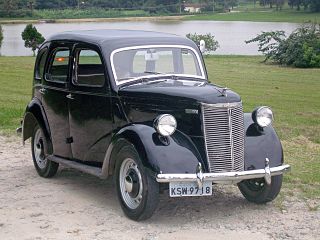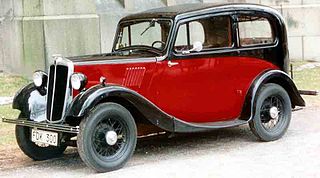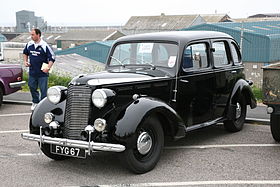
The Ford Prefect is a line of British cars which was produced by Ford UK between 1938 and 1961 as an upmarket version of the Ford Popular and Ford Anglia small family cars. It was introduced in October 1938 and remained in production until 1941. Returning to the market in 1945, it was offered until 1961. The car progressed in 1953 from its original perpendicular or "sit-up-and-beg" style to a more modern three-box structure. Some versions were also built and sold by Ford Australia.

The Hillman Minx was a mid-sized family car that British car maker Hillman produced from 1931 to 1970. There were many versions of the Minx over that period, as well as badge-engineered variants sold by Humber, Singer, and Sunbeam.

The Opel Omega is an executive car engineered and manufactured by German automaker Opel between 1986 and 2004. The first generation, the Omega A (1986–1993), superseded the Opel Rekord. It was voted European Car of the Year for 1987, and was available as a saloon or estate. The second generation, the Omega B, was manufactured from 1993 to 2004.

The Opel Monza is an executive fastback coupe produced by the German automaker Opel from 1977 to 1986. It was marketed in the United Kingdom as the Vauxhall Royale Coupé by Vauxhall.

The Holden Gemini is a compact car that was produced by Holden and sold in Australasia from 1975 to 1986. It was based on the Japanese Isuzu Gemini, one of the many models based on the GM T-car platform.

The Morris Eight is a small family car produced by Morris Motors from 1935 to 1948. It was inspired by the sales popularity of the Ford Model Y, styling of which the Eight closely followed. The success of the car enabled Morris to regain its position as Britain's largest motor manufacturer.

The Holden was a full-sized car produced by the company of the same name across 5 generations from 1948 until 1984. The Holden is also commonly referred to by their model designation and also the H Series. The Holden was introduced to be Australia's car, being the first full scale produced automobile exclusive to the country. Prior to which, General Motors Holden's Ltd. assembled imported CKD kits from overseas General Motors subsidiaries such as Chevrolet, Buick, Vauxhall and more. And the only other cars built in the country being Ford and Chrysler vehicle bodies fitted to imported chassis. The Holden was an instant success among Australians, being the first production car built solely for Australia's unique, rough roads.

The Standard Vanguard is a car which was produced by the Standard Motor Company in Coventry, England, from 1947 until 1963.

The Triumph Mayflower is a British four-seat 1+1⁄4-litre small luxury car noted for its razor-edge styling. It was built by the Standard Motor Company and sold by Standard's subsidiary, The Triumph Motor Company. It was announced at the October 1949 British International Motor Show, but deliveries did not commence until the middle of 1950.

The Morris Ten announced 1 September 1932 is a medium-sized car introduced for 1933 as the company's offering in the important 10 hp sector of the British market. It continued through a series of variants until October 1948 when along with Morris's Twelve and Fourteen it was replaced by the 13.5 hp Morris Oxford MO.

The Vauxhall Wyvern is a medium-sized family car introduced by Vauxhall in 1948 as a successor to the Vauxhall 12. The name comes from the mythical beast the wyvern, and may be due to a misidentification of the heraldic griffin on the Vauxhall badge.

The Vauxhall Velox is a six-cylinder executive car which was produced by Vauxhall from 1948 to 1965. The Velox was a large family car, directly competing in the UK with the contemporary six-cylinder Ford Zephyr, and to a slightly lesser extent, with the A90, A95, and A110 Austin Westminster models.

The Vauxhall 10-4 is a British-built small family car produced by Vauxhall between 1937 and 1947. It was launched at the October 1937 London Motor Show and was the first British car to have a unitary construction body. The first car was delivered to a customer on 1 November 1937.

The Holden HD series is a range of automobiles which were produced by Holden in Australia from 1965 to 1966.

The Holden HR is an automobile that was produced by Holden in Australia from 1966 to 1968.

A coupé utility is a vehicle with a passenger compartment at the front and an integrated cargo tray at the rear, with the front of the cargo bed doubling as the rear of the passenger compartment.
The Singer Ten name was used for several automobiles produced by Singer Motors between 1912 and 1949. The "Ten" in the name referred to the taxation horsepower rating in the United Kingdom.

The Vauxhall Light 6 is an automobile which was produced by Vauxhall in the United Kingdom from 1933 to 1938.

The Vauxhall Big 6 is a name given to a series of automobiles which was produced by Vauxhall in the United Kingdom from 1934 to 1940. Rolling chassis were also bodied in Australia.

The Bedford HC is a small commercial vehicle that was made by Bedford, beginning in 1938. The vehicle shared its running gear with the H-series Vauxhall 10-4 saloon. Production of civilian vehicles ceased during World War II with the HC van re-entering production for a little while following hostilities. The HC was later joined by the heavier duty Bedford JC, which was itself replaced by the higher-roofed Bedford PC after the war. With the arrival of the much more modern Bedford CA the by now outmoded PC was finally retired.























